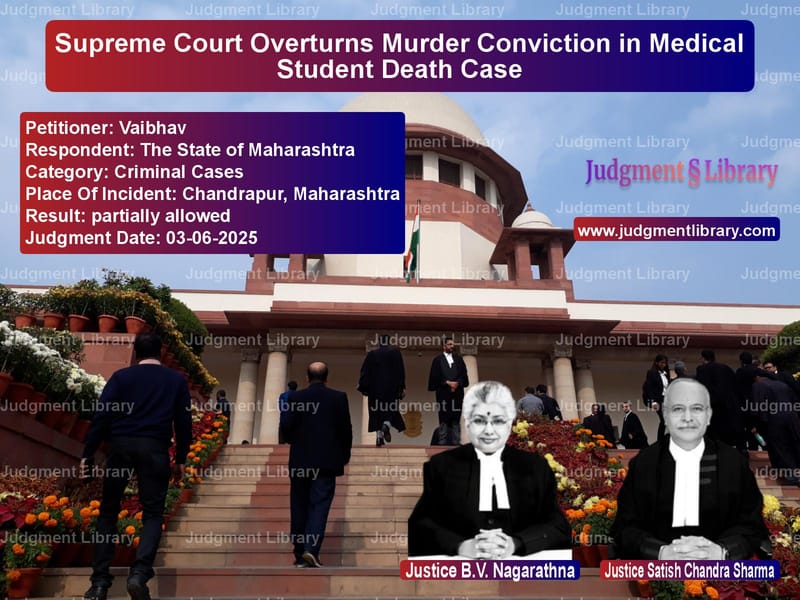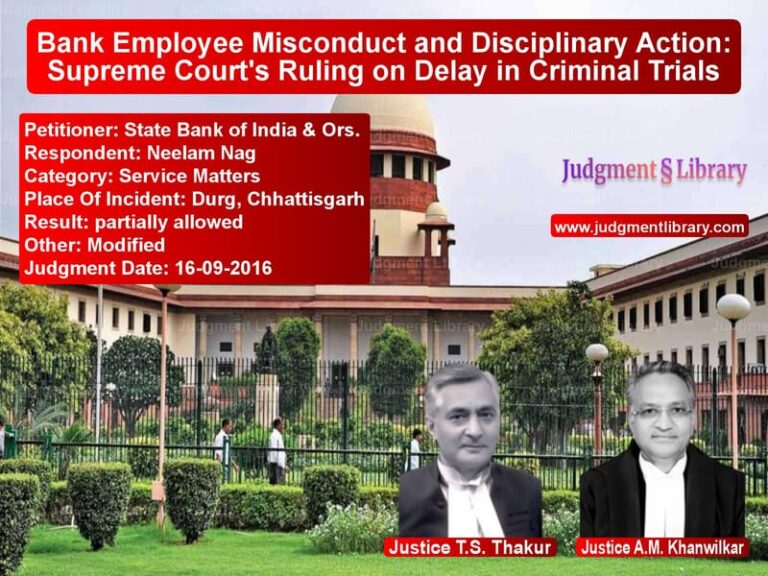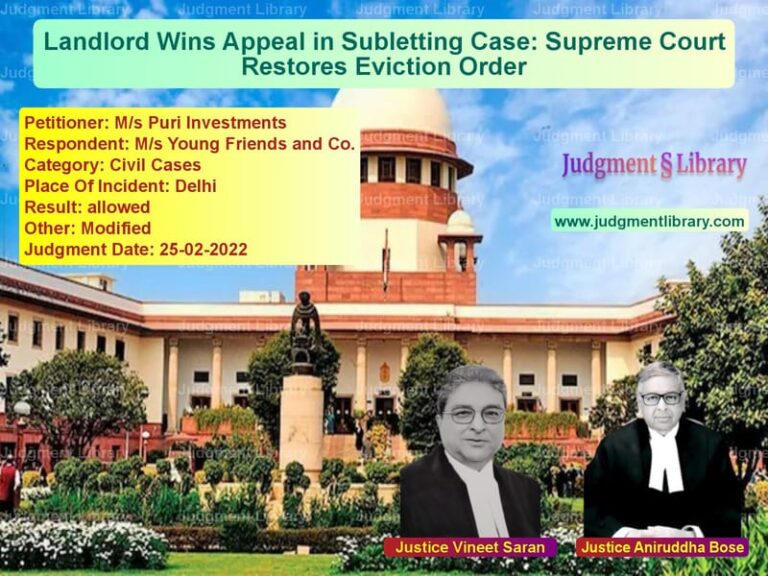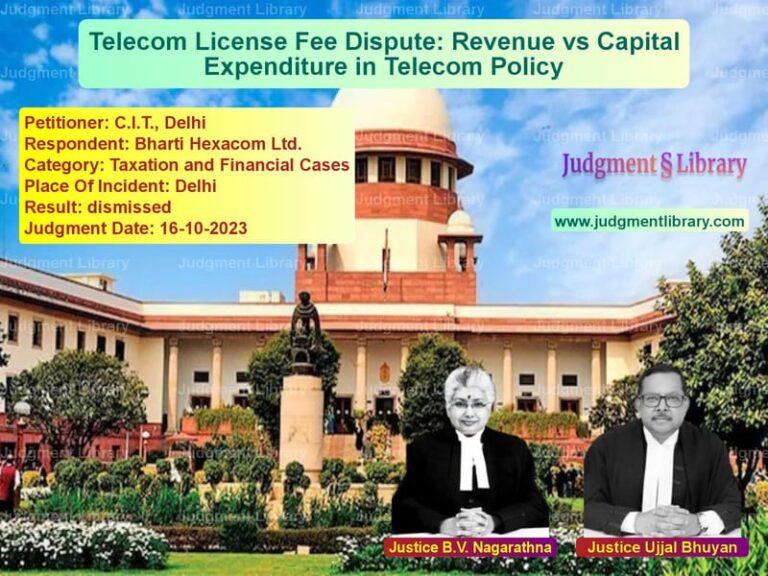Supreme Court Overturns Murder Conviction in Medical Student Death Case
In a significant criminal law judgment, the Supreme Court of India has overturned the murder conviction of Vaibhav, a medical student accused of killing his friend Mangesh, highlighting crucial legal principles regarding circumstantial evidence, burden of proof, and the importance of medical evidence in criminal trials. The case, which traveled through multiple judicial forums over more than a decade, serves as an important reminder of the fundamental protections afforded to accused persons under Indian law and the careful scrutiny required in cases based entirely on circumstantial evidence.
The Tragic Incident
The case began as a tale of two friends, Vaibhav and Mangesh, who were studying together at Bagla Homeopathy Medical College in Chandrapur, Maharashtra. Both were first-year students and often commuted together on their two-wheelers. On September 16, 2010, both friends left college together on Mangesh’s scooter, had tea at a local stall, and arrived at Vaibhav’s house in the afternoon. When Mangesh’s father discovered late in the evening that his son had not reached home, he tried to find him and eventually lodged a missing report. The next day, on September 17, 2010, Mangesh’s dead body was found, leading to the registration of a criminal case against unknown persons.
During investigation, suspicion fell upon Vaibhav, Mangesh’s friend, classmate, and scooter partner. The police chargesheet alleged that Vaibhav had caused Mangesh’s death by shooting him with a gun belonging to Vaibhav’s father. The prosecution case was that after killing Mangesh, Vaibhav called his friends Vishal and Akash (a juvenile) to help dispose of the dead body.
The Trial Court and High Court Proceedings
The Trial Court found Vaibhav guilty under Sections 302, 201 read with Section 34 of Indian Penal Code and Section 5 read with 25(1)(a) of Arms Act. His friend Vishal was also found guilty under Section 201 read with Section 34 of IPC. Both convicts preferred separate appeals before the Bombay High Court, which upheld Vaibhav’s conviction but acquitted Vishal for want of evidence. Vaibhav then approached the Supreme Court challenging his conviction.
The High Court had heavily relied on Section 8 of the Indian Evidence Act to draw inferences from Vaibhav’s subsequent conduct, particularly his removal of the dead body, concealment of evidence, and his visits to Mangesh’s father pretending to enquire about the deceased. The High Court observed: “The fact that the accused attempted to stifle the investigation is relevant under Section 8 of the Indian Evidence Act. The fact of fear as deposed by A1, accepted by the accused is relevant.”
Arguments Before the Supreme Court
The appellant’s counsel raised several crucial arguments challenging the conviction. He emphasized that according to the evidence of PW-9, the trajectory of the bullet was such that it had exited from the downward portion of the skull of the deceased and then hit the ventilator above the door. He argued that such trajectory was only possible in case of suicidal death and not homicidal. He further submitted that the courts below had erred in not appreciating the testimony of PW-9, who had clearly deposed that she could not ascertain the cause of death and could not tell with certainty whether the death was suicidal or homicidal.
Relying on medical jurisprudence, the counsel submitted that in cases of accidental injuries by firearm, the bullet is hit from a close distance and the injury is often singular. He pointed out that both these elements were present in this case. Regarding Vaibhav’s conduct after the incident, the counsel submitted that Vaibhav had categorically deposed that Mangesh’s death was caused by his father’s pistol at his residence accidentally. He explained that when he heard the gunshot, he came out and saw Mangesh’s body lying in pool of blood, got scared of his father, and tried to clean up the scene.
The counsel emphasized the absence of motive, stating that in a case based on circumstantial evidence, this crucial fact rendered the prosecution case doubtful. He argued that the courts below had placed undue burden upon Vaibhav to offer explanation for certain circumstances and his subsequent conduct, when it was for the prosecution to prove its case beyond reasonable doubt.
The Supreme Court’s Analysis
The Supreme Court began its analysis by acknowledging certain admitted facts: the cause of death was undisputed as the deceased was shot by the service pistol belonging to Vaibhav’s father; Vaibhav had indeed removed the dead body and cleaned up the scene of crime; and discoveries made under Section 27 of Evidence Act were not challenged by the appellant. However, the Court noted that while these aspects were relevant for the offence under Section 201 IPC, they left unanswered the crucial question for the murder charge: who pulled the trigger?
The Court conducted a detailed examination of the medical evidence, particularly the trajectory of the bullet. PW-9 had deposed that the bullet entered through the eye of the deceased and exited from the lower part of the skull from the back, then hit against a ventilator installed above the door of the living room. The Court noted that the ventilator was installed at a height significantly higher than the height of the deceased, meaning the bullet traveled upwards after leaving the skull.
The Court made a crucial observation: “In usual course of things, such trajectory of the bullet could have been possible only if the deceased was sitting and looking downwards towards the barrel of the pistol from a close distance. It was only then that the bullet could have hit the ventilator despite exiting from the lower part of the skull. In fact, this is precisely the defence of the appellant – that the deceased, on finding the service pistol of PW-12, got curious, picked it up, started looking into it with one eye from a close distance and accidentally pressed the trigger. The probability of the version put across by the appellant is on the higher side as compared to the version put across by the prosecution, which simply does not give any explanation for the trajectory of the bullet.”
Burden of Proof and Subsequent Conduct
The Court strongly criticized the High Court’s approach of relying heavily on Vaibhav’s subsequent conduct to establish guilt for murder. The Court emphasized fundamental principles of criminal jurisprudence: “In criminal jurisprudence, it is a time-tested proposition that the primary burden falls upon the shoulders of the prosecution and it is only if the prosecution succeeds in discharging its burden beyond reasonable doubt that the burden shifts upon the accused to explain the evidence against him or to present a defence. In the present case, the version of the prosecution suffers from inherent inconsistencies and doubts, as discussed above, and in such a scenario, the inability of the appellant to explain certain circumstances could not be made the basis to relieve the prosecution from discharging its primary burden.”
The Court noted that the High Court had erroneously concluded that Vaibhav had “admitted” to the homicidal death, when in fact he had consistently maintained that the death was accidental. The Court observed: “There is no such admission qua the nature of death. Contrarily, the appellant had deposed on oath that the death was ‘accidental’, a version that he has carried consistently up to this Court.”
Absence of Motive and Alternate Theory
The Court extensively discussed the relevance of motive in cases based on circumstantial evidence. Quoting from its earlier decision in Anwar Ali & Anr. v. State of Himachal Pradesh, the Court noted: “absence of motive in a case depending on circumstantial evidence is a factor that weighs in favour of the accused.” The Court further elaborated: “In cases purely based on circumstantial evidence, the absence of motive could raise serious questions and might even render the chain of evidence as doubtful. It is so because the presence of motive does the job of explaining the circumstantial evidence.”
The Court found that the evidence consistently showed that Vaibhav and Mangesh were friends with no ill-will between them, making the murder theory less probable. The Court also found Vaibhav’s explanation for his subsequent conduct to be consistent with the theory of accidental death: “A young boy studying in first year of college, with no criminal background and with no motive in sight, would certainly have become scared on seeing that his friend has accidentally shot himself in the living room of his house with the pistol belonging to his father and is lying in a pool of blood. The subsequent conduct of cleaning up the scene and restoring the living room in its original shape, although punishable in law, does not become so unnatural that it could be made the basis to convict him for the commission of murder without additional evidence to that effect.”
Conclusion and Legal Principles
The Supreme Court reiterated the fundamental principle that “mere suspicion, no matter how grave, cannot take the place of proof in a criminal trial.” The Court emphasized that in cases based purely on circumstantial evidence, the chain of circumstances must be complete and consistent with the conclusion of guilt only, and must not support a contrary finding.
The Court also reinforced the principle that when two different views appear reasonably possible, the matter must be decided in favour of the accused: “It is a time-tested proposition of law that when a Court is faced with a situation wherein two different views appear to be reasonably possible, the matter is to be decided in favour of the accused. The benefit of a counter possibility goes to the accused in such cases.”
Accordingly, the Supreme Court partially set aside the impugned order and judgment, acquitting Vaibhav of the offences under Section 302 of IPC and Section 5 read with 25(1)(a) of Arms Act. However, his conviction under Section 201 IPC was sustained, and he was sentenced to the period already undergone.
This judgment serves as an important reinforcement of fundamental criminal law principles in India, particularly in cases based on circumstantial evidence. It underscores that convictions cannot be based on mere suspicion, speculative inferences, or the inability of the accused to explain certain circumstances. The prosecution must prove its case beyond reasonable doubt through reliable and consistent evidence that leaves no room for reasonable alternate possibilities. The decision also highlights the crucial role of medical evidence in cases involving firearm injuries and the importance of properly analyzing technical aspects like bullet trajectory to arrive at correct conclusions about the nature of death.
Petitioner Name: Vaibhav.Respondent Name: The State of Maharashtra.Judgment By: Justice B.V. Nagarathna, Justice Satish Chandra Sharma.Place Of Incident: Chandrapur, Maharashtra.Judgment Date: 03-06-2025.Result: partially allowed.
Don’t miss out on the full details! Download the complete judgment in PDF format below and gain valuable insights instantly!
Download Judgment: vaibhav-vs-the-state-of-maharas-supreme-court-of-india-judgment-dated-03-06-2025.pdf
Directly Download Judgment: Directly download this Judgment
See all petitions in Murder Cases
See all petitions in Judgment by B.V. Nagarathna
See all petitions in Judgment by Satish Chandra Sharma
See all petitions in partially allowed
See all petitions in supreme court of India judgments June 2025
See all petitions in 2025 judgments
See all posts in Criminal Cases Category
See all allowed petitions in Criminal Cases Category
See all Dismissed petitions in Criminal Cases Category
See all partially allowed petitions in Criminal Cases Category







